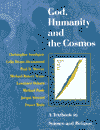A Classification of Theories of Divine Action
We give a brief summary of each theory. The best way to compare them in detail is to ask - what, for each theory, is
‘the causal joint’ at which God - as a transcendent, immaterial world cause -
interacts particularly with causative factors in the material world? The best way to compare them in detail is to ask - what, for each theory, is
‘the causal joint’ at which God - as a transcendent, immaterial world cause -
interacts particularly with causative factors in the material world?
i) sceptical naturalism - Willem B
Drees has surveyed the field with characteristic insight, but is reluctant to speak of particular divine action because this might seem
to undermine the adequacy of naturalistic explanations, to which he is
committed. For different reasons Bultmann and his school also insisted on the
adequacy of the scientific description of events, but is reluctant to speak of particular divine action because this might seem
to undermine the adequacy of naturalistic explanations, to which he is
committed. For different reasons Bultmann and his school also insisted on the
adequacy of the scientific description of events, as do non-realist theologians such as Don Cupitt. Drees’ view of the
causal-joint question would be that to search for an extra ingredient at a
causal joint is to neglect the self-sufficiency of naturalistic accounts, one
of the premises he sets out so clearly at the beginning of Religion, Science and Naturalism. as do non-realist theologians such as Don Cupitt. Drees’ view of the
causal-joint question would be that to search for an extra ingredient at a
causal joint is to neglect the self-sufficiency of naturalistic accounts, one
of the premises he sets out so clearly at the beginning of Religion, Science and Naturalism.
ii) general providential action without
particular gaps in the causal order - espoused by Gordon Kaufman in his God the Problem (1972) and even more radically by Maurice Wiles in God’s
Action in the World (1986). and even more radically by Maurice Wiles in God’s
Action in the World (1986). Kaufman and Wiles both reject descriptions of divine action as particular to
individual situations. God’s relation is to the-world-as-a-whole, and
history-as-a-whole, the relation of creating and sustaining the cosmos from
moment to moment. There is no particular causal joint, only the overall
creator-creature relation. As Tracy points out, this is essentially to subsume
providence into creation, and pays a heavy theological price in so doing. Kaufman and Wiles both reject descriptions of divine action as particular to
individual situations. God’s relation is to the-world-as-a-whole, and
history-as-a-whole, the relation of creating and sustaining the cosmos from
moment to moment. There is no particular causal joint, only the overall
creator-creature relation. As Tracy points out, this is essentially to subsume
providence into creation, and pays a heavy theological price in so doing.
iii) particular providential action
without gaps in the causal order - in different ways this is proposed by
iv) particular providential action
employing particular gaps in the causal order. Again there are three camps
here
Email
link | Feedback | Contributed by: Dr.
Christopher Southgate
Source: God, Humanity and the
Cosmos (T&T Clark, 1999)
|




